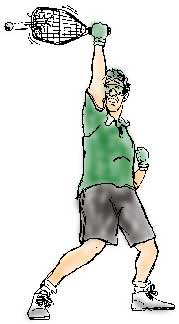|
|

Why Strings Break
By Steve Crandall
Vice President, Sales & Marketing
Ashaway Racket Strings
 A broken string is always a hassle, even if you have a spare racquet. It breaks your concentration, and forces you to adjust to a different racquet in the middle of a match-which can mean several lost points. A broken string is always a hassle, even if you have a spare racquet. It breaks your concentration, and forces you to adjust to a different racquet in the middle of a match-which can mean several lost points.
Even with improvements in string technology, breakage is more common than ever, because of today's huge racquet faces and open string patterns. In order to reduce breakage, it is important to understand that it has four different causes.
The first cause is stretching beyond the string's elastic limits-similar to pulling a rubber band until it snaps. Because racquetball is primarily a power game, this is the most common break. It usually occurs on one of the central four main strings, within an inch or two of the racquet's head.
The sweet spot is the most resilient-and hence most powerful-area on the racquet. No matter how clever racquet designers may be, they'll never be able to get the sweet spot more than about 3/4 of the way up the face. Every time you grab a shot off the wall, you're hitting above the sweet spot, in a relatively unresilient area. There's simply not much string to stretch between the ball and the head of the racquet, and if the forces are too great, it snaps.
Stringing at lower tension will reduce the incidence of this problem, as will the use of a high-tensile-strength string-for example, a Kevlar(r)-cored string like DuraKill(tm), or a hybrid string set with Kevlar mains, like Killfire(tm). Another solution is to increase string thickness, moving from an 18 or 17 gauge up to a 16 or 15 gauge.
Other relatively common causes of breakage are string-to-string abrasion and cutting. Every time you hit the ball, the cross strings pound against the main strings. In time, they can cut through the outer jacket and into the core. Likewise, "cutting" and underspin shots cause the strings to "saw" back and forth against each other, with much the same effect. Again, thick string withstands this longer than thin string.
Over-stressing, and string-against-string forces are inherent in the game. They're not entirely avoidable, but you can take steps to reduce their effects. Other types of breaks are due to racquet defects, and can be completely eliminated with proper attention.
A broken, split grommet may present a sharp edge that can cut into the string. If the grommet is missing, the frame itself may cut the string. Next time the strings are out of your racquet, feel the edges of the holes that are drilled into the frame: they may be quite sharp.
The simple solution is to make sure the grommets are sound. A new grommet strip may cost $5 or $6: well worthwhile if it saves you a $20 stringing job. If the proper grommet strip is unavailable, your stringer may be able to install a piece of plastic tubing as a temporary repair.
Frequent wall-bangers will occasionally abrade the string where it passes between two grommets on the outside of the frame, at the head of the racquet. This is an uncommon cause of breakage, and it generally occurs only if the proper bumper strip is not installed.
Even with proper care, some string breakage is inevitable. As a string ages, it becomes abraded and loses resiliency. Your best bet is to restring before such degradation occurs: newer strings perform better, and you'll be surprised less often in the middle of a match.
This article previously appeared in Racquetball Magazine.
|